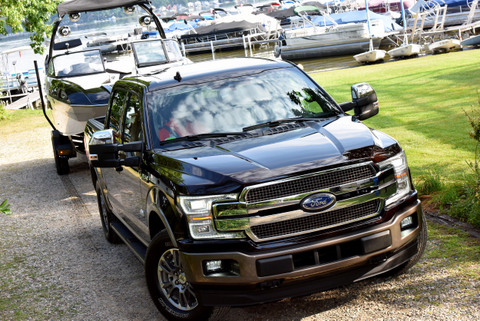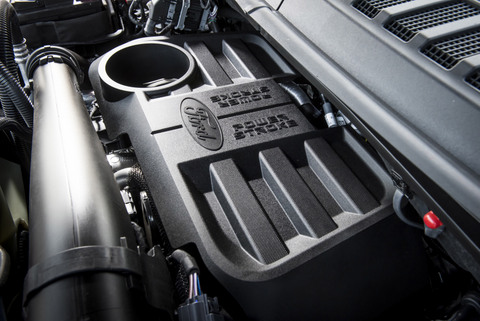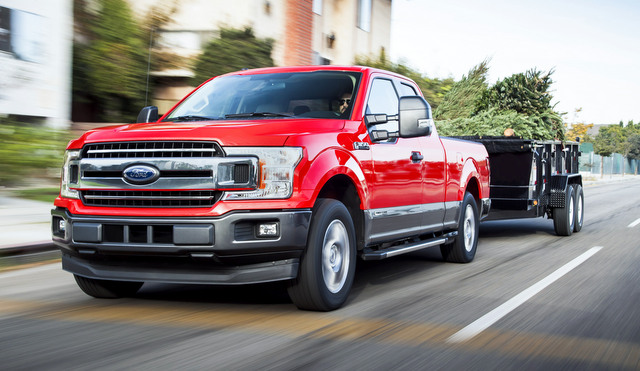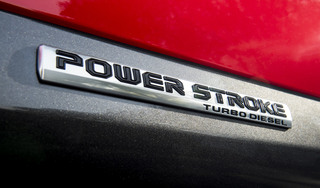Road Test Reveals Impressive Towing, Fuel Economy Numbers, But It Ain’t Cheap
Passenger car diesels have had a rough go the past couple of years thanks to the backlash against the fuel since Volkswagen admitted rigging its cars to fraudulently pass emissions tests. But sitting in a 2018 Ford F-150 diesel half-ton pickup truck, it was hard to understand that the fuel could ever become extinct.
Diesels make more torque, which is better for towing and hauling heavy loads. Diesels also typically get about 30 percent better fuel economy than a comparable gasoline engine. Plus, modern day diesel engines don’t emit that black exhaust.

Another bonus of modern diesels is the sound; outside or in, it’s no longer loud, harsh or crude. And quiet the 2018 F-150 diesel was—idling at the drive-through or at wide-open throttle. The 3.0-liter Power Stroke was impressively hushed. The noise it made was smooth, refined and completely unobtrusive. If noise is your worry about buying a diesel, rest assured that with the F-150 diesel noise is a nonissue.
After a week of driving a 2018 Platinum trim four-wheel drive SuperCrew, here are five things to know about the F-150 Power Stroke diesel pickup. I take a look beyond Ford’s advertising and marketing headlines; you should, too. You might be surprised.
1-The Power Stroke Diesel Powertrain
Open the hood of the 2018 Ford F-150 diesel and you will find nestled beneath the aluminum body panels a 60-degree V-6 dual overhead cam (DHOC) 3.0-liter Power Stroke diesel engine. The Power Stroke six is a single turbocharged engine that’s derived from an earlier Land Rover motor that has undergone significant changes.

The block is a compacted graphite-iron casting. New components include a forged crankshaft with specific rod and crank bearings and a variable-geometry turbocharger. A common-rail fuel injection system precisely optimizes performance and fuel efficiency with a high-pressure 29,000 pounds per square inch injection calibration. Twin fuel filters and a dual-stage oil pump address purity and lubrication issues.
The result is a motor that cranks out 250 horsepower and 440 pounds-feet of torque, which is currently best-in-class territory. While that 250 horsepower figure may seem a little weak, it’s the 440 pounds-feet of torque that is of interest to those who work their trucks hard with towing and hauling.
The F-150 diesel is mated to a 10-speed automatic transmission calibrated specifically for the Power Stroke diesel’s low-end power and torque curves. To help save fuel and cut back on emissions, engine start-stop is standard.
Perks in our four-wheel drive F-150 Premium SuperCrew diesel included selectable drive modes of Normal, Snow/Wet, Tow/Haul, Eco and Sport. The 4WD transfer case, in addition to the expected 2H, 4H and 4L choices, also boasted an all-wheel drive “4A” selection.
2-Fuel Economy
Ford likes to point out that: “The 2018 Ford F-150’s first 3.0-liter Power Stroke diesel engine officially boasts EPA-estimated ratings of 30 mpg highway, 22 mpg city and 25 mpg combined,” and that those EPA numbers are the highest of any full-size truck.
While the F-150 diesel’s EPA figures are impressive, dig a little deeper and you will find out that they’re only for the two-wheel drive version of the pickup. If you want the four-wheel drive model, that comes with a compromise in economy. Expect to get 25 mpg/ highway/20 city/22 combined. A five mpg lower fuel economy rating on the highway is a really big difference.
Yes, 30 mpg for a pickup is a big deal—at least until we hear what the new 2019 Ram 1500 EcoDiesel and the upcoming Chevrolet Silverado 1500’s 3.0-liter turbocharged in-line six-cylinder bring to the party.
3-Variety Is Key—Available Body Styles, Trim Levels and Features
Buyers of the 2018 Ford F-150 Power Stroke diesel have a choice of two body styles: SuperCrews with either a 5.5-foot or 6.5-foot bed configuration or SuperCabs with a 6.5-foot bed configuration. The primary difference between these two models, which offer the same number of seats, is the doors. A SuperCab has two full doors in the front, and two half doors for the back row, while the SuperCrew provides everyone with a full door.

There are three trim options: The Lariat, King Ranch and Platinum. Only fleet customers can opt for the diesel on the lower XL and XLT trims.
When it comes to features, it’s almost limitless on the 2018 Ford F-150 Power Stroke. Surround cameras and active lane control, power running boards, blind-spot monitor, tailgate step, a bed extender, box side steps, adaptive cruise control, park assist, a moonroof and inflatable rear seatbelts are just a few.
For novice towers our test truck had the optional Pro Trailer Backup Assist. It eases the anxiety typically associated with learning to back up a trailer on the spot by maneuvering the truck in a way that manipulates the trailer into a parking slot.
4-Towing and Hauling Have a Catch
Ford touts that with the diesel engine the F-150 is rated to tow up to 11,400 pounds with a maximum payload capacity of 2,020 pounds. That’s only true if you are a fleet customer.

Retail customers will find the 2018 Ford F-150 Power Stroke diesel trucks have a tow rating of 10,100 pounds (1,100 pounds less) and a payload capacity of 1,940 pounds (80 pounds less).
5-How Much Does The 2018 Ford F-150 Diesel Cost?
Well, it ain’t cheap.
You have to start with a Lariat SuperCab that has a sticker price of $41,015. The Power Stroke up-charge is $4,000 on the Lariat. That means the least expensive F-150 Power Stroke runs just north of $45,000. Add a few options like four-wheel drive, and it wouldn’t be difficult to see a sticker climb above $50,000.
Want a SuperCrew with four full-size doors? Dig deep into your wallet because the diesel option is $9,000.
Oh, diesel emissions fluid DEF) refills will set you back $24 every 7,000 miles.
Is The 2018 Ford F-150 Power Stroke Worth It?

It depends. The answer is yes if you plan on doing a lot of towing over long distances or you do a lot of highway driving. The answer is no if you have pretty much any other uses.
Related Stories You Might Enjoy—The Truck Competition
Road Test: 2018 Chevrolet Colorado Duramax Diesel
Tech: 2019 Ram 1500 Hybrid
News: Chevrolet Silverado Diesel
Road Test: 2016 Ram 1500 EcoDiesel
Road Test: 2016 Nissan Titan
Road Tests: 2015 Ram 3500 Cummins Diesel
Disclosure:
Clean Fleet Report is loaned free test vehicles from automakers to evaluate, typically for a week at a time. Our road tests are based on this one-week drive of a new vehicle. Because of this we don’t address issues such as long-term reliability or total cost of ownership. In addition, we are often invited to manufacturer events highlighting new vehicles or technology. As part of these events we may be offered free transportation, lodging or meals. We do our best to present our unvarnished evaluations of vehicles and news irrespective of these inducements.
Our focus is on vehicles that offer the best fuel economy in their class, which leads us to emphasize electric cars, plug-in hybrids, hybrids and diesels. We also feature those efficient gas-powered vehicles that are among the top mpg vehicles in their class. In addition, we aim to offer reviews and news on advanced technology and the alternative fuel vehicle market. We welcome any feedback from vehicle owners and are dedicated to providing a forum for alternative viewpoints. Please let us know your views at publisher@cleanfleetreport.com.

5 thoughts on “5 Things To Know About the 2018 Ford F-150 Power Stroke Diesel Pickup”